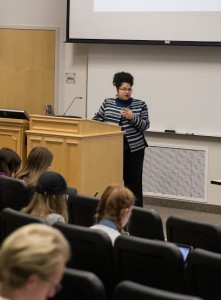
(Maddi Dayton)
Arizona State professor of Women and Gender Studies Sujey Vega visited BYU campus for the first time on Friday, Mar. 11, 2016. Vega spoke on the past and present experience of LDS Latina Relief Society Members as part of the Women’s Studies Colloquium.
Vega shared several past and present inspiring stories from Latina women who explained how the Relief Society has helped them through hard times. She said women arrived to Spanish branches seeking sisterhood and support.
“Their sisterhood ties and fortitude of faith is inspiring. It perhaps opens our understanding of what Latina sisters might encounter today as they intersect with gender, ethnicity, class, family, identity, religion and aging,” Vega said.
Vega explained theorizing female social networks has helped her understand how and why Mormon Latinos have come to develop this sisterhood within the church.
“Co-mothers help one another locate critical resources and provide friendship where there might be despair. This cultural and religiously grounded social network also reduces feelings of isolation for women who are perceived as perpetual foreigners ,” Vega said.
This sisterhood that serves as a support system has especially worked for those who need one another mentally, spiritually and temporarily, according to Vega.
She said “Latinas hunger for social network” where they can share familiar experiences and find strength in order to survive the opposition they face in everyday society.
Vega said according to clinical physiologists, “the transition from a deeply social Latin American community to one of isolation and suffering leads to alienation.” She also said a Latina who experiences such change is prone to anxiety, depression and hopelessness.
Women who share this type of suffering are likely to make a closer bond that is needed in a very biased society, according to Vega.
“It serves as a support mechanism to help fight back against loneliness and depression; or attacks they face from systems of inequality fueled by race, immigration and gender,” Vega said.
She also said this sisterhood could be considered “a sacred space in which to heal,” a healing for all concepts that converge and overlap with the Mormon sisterhood. She explained what Mormon sisters go through now is similar to what they go through today.
“This deep connection and dependence of one another is impressing once we take into consideration what LDS women were experiencing as minority faith individuals themselves,” Vega said
Early female converts in the church experience feelings of isolation and struggle to adapt to a new sisterhood because they often “abandon old social and emotional attachments,” giving them more reason to find a sisterhood, according to Vega.
Vega explained that Latina women who find these bonds are often more included in church activity and find the confidence they need that cannot be found in today’s society.
“In exploring politics of everyday life, Latinas initially struggle to take up leadership roles, but months later they often project much more assured confidence in front of a congregation,” Vega said.
Today, some LDS Latinas share the concern of “forgetting what it means to be Hispanic” in a very white predominant faith, according to Vega.
“They are concerned for their grandchildren who might not see the richness in their heritage,” Vega said.
She cautioned it is important to create a safe space as many Latinas attempt or are pressured to assimilate in a very ethnic-threatening society.
“The decisions on how young Latina women develop (their) identity and combat injustice are not easily made. They are that much more difficult when having to confront them alone,” Vega said.
She said this next generation of LDS Latina women will need each other to face the world around them, co-mothering one other in time of despair and rejoicing.




